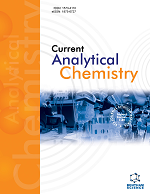- Home
- A-Z Publications
- Current Analytical Chemistry
- Previous Issues
- Volume 3, Issue 4, 2007
Current Analytical Chemistry - Volume 3, Issue 4, 2007
Volume 3, Issue 4, 2007
-
-
The Use of Atmospheric Pressure Chemical Ionization Mass Spectrometry with High Performance Liquid Chromatography and Other Separation Techniques for Identification of Triacylglycerols
More LessAuthors: Tomas Rezanka and Karel SiglerTriacylglycerols (TAGs) are widely distributed, if not universal, in edible plants and edible plant triacylglycerols are nutrients forming an important part of the human diet. TAGs of higher plants consist mainly of esters of glycerol with fatty acids, many of which are essential as human nutrients and are therefore in the center of increasing attention. Despite their importance, the molecular species of each TAG class have not yet Read More
-
-
-
Purification of Transcription Factors and Identification with Mass Spectrometry
More LessAuthors: Shoulei Jiang, Linda Nagore, Daifeng Jiang, Robert A. Moxley and Harry W. JarrettTranscription factors are a large and diverse group of proteins which bind to DNA response elements in the promoters of genes either activating or repressing gene expression. The purification and characterization of transcription factors has been improving at a rapid pace. New purification techniques, including oligonucleotide trapping, and improved methods of detection, including chromatin immunoprecipitation have been Read More
-
-
-
31P NMR Spectroscopy of Phospholipids: From Micelles to Membranes
More LessAuthors: Jurgen Schiller, Matthias Muller, Beate Fuchs, Klaus Arnold and Daniel HusterPhospholipids are the main constituents of biological membranes. Their amphiphilic character is responsible for the typical bilayer arrangement as the structural basis of biological membranes. In addition to their structural role, some phospholipids are of significant functional importance. They act as intercellular messengers and are involved in the pathogenesis of many diseases. Therefore, phospholipid research (“lipidomics”) Read More
-
-
-
Pitfalls in High Throughput Screening for Drug Absorption Optimization in Drug Discovery
More LessAuthors: Hiroshi Komura and Masahiro IwakiImplementation of combinatorial chemistry and high throughput screening to biological targets has led to produce lipophilic and poorly water soluble lead compounds. Since these compounds show poor absorbability, high throughput methods for improving solubility and membrane permeability have been developed. Kinetic solubility of compounds after dilution of dimethyl sulfoxide solution into aqueous buffer is det Read More
-
-
-
Hollow-Fiber Flow Field-Flow Fractionation
More LessAuthors: Andrea Zattoni, Sonia Casolari, Diana C. Rambaldi and Pierluigi ReschiglianField-flow fractionation (FFF) is a family of separation techniques able to fractionate a broad range of macromolecules, nano- and micro-sized particles of different origin. Among FFF, flow FFF (FlFFF) shows the highest separation versatility, and today it is the only FFF technique with significant market relevance. Commercial FlFFF employs macro-scale, flat-type channels. The idea of hollow-fiber (HF) membranes as tu Read More
-
Volumes & issues
-
Volume 21 (2025)
-
Volume 20 (2024)
-
Volume 19 (2023)
-
Volume 18 (2022)
-
Volume 17 (2021)
-
Volume 16 (2020)
-
Volume 15 (2019)
-
Volume 14 (2018)
-
Volume 13 (2017)
-
Volume 12 (2016)
-
Volume 11 (2015)
-
Volume 10 (2014)
-
Volume 9 (2013)
-
Volume 8 (2012)
-
Volume 7 (2011)
-
Volume 6 (2010)
-
Volume 5 (2009)
-
Volume 4 (2008)
-
Volume 3 (2007)
-
Volume 2 (2006)
-
Volume 1 (2005)
Most Read This Month
Article
content/journals/cac
Journal
10
5
false
en


